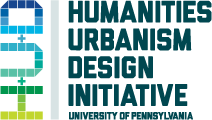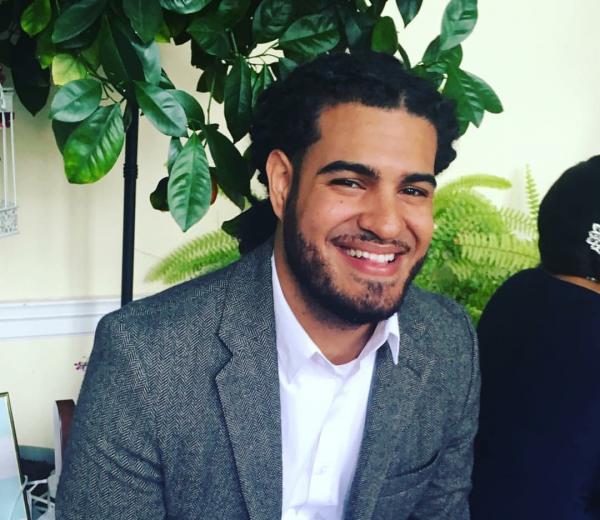News
Feature on H+U+D Anchor Institution Seminar with Taller Puertorriqueño
08.13.21
COMMUNITY BUILDERS | Omnia
Daniel Morales-Armstrong, William Fontaine Fellow of Africana Studies and History, helms a course designed to lead students in a collaborative engagement with a local Philadelphian community.
Thursday, August 5, 2021
By Blake Cole
As an instructor of a seminar that focuses on community, Daniel Morales-Armstrong didn’t want to waste any time getting boots to the ground.
“In our pandemic reality, it’s easy to say, ‘Okay, we’re looking at this area, let’s hop online and let’s get the Google satellite images.’ But you need to be in a place to feel the place, while also, of course, being safe,” says Morales-Armstrong, William Fontaine Fellow of Africana Studies and History. “It’s the sounds, it’s the sights, it’s the people. It’s the way that the public space is utilized and is the grounds for a multidirectional conversation.”
The seminar, “The Inclusive City: Participatory Design at Taller Puertorriqueño,” which took place during the spring 2021 semester, grew out of the Humanities + Urbanism + Design Initiative (HUD), a collaboration between Penn Arts & Sciences, the Weitzman School of Design, and the Penn Institute for Urban Research. HUD bridges the humanities and design disciplines to create a vehicle to both stimulate inter- and multi-disciplinary work on diversity and inclusion in the built environment, and build an increasingly diverse and inclusive community of scholars who do this work. HUD accomplishes this through co-taught courses, a colloquium, undergraduate and graduate fellowships, a postdoctoral junior fellowship, and more. The initiative, which was launched by an award from The Andrew Mellon Foundation in 2013, was founded by Eugenie Birch, Lawrence C. Nussdorf Professor of Urban Research and Education in the Weitzman School, and David Brownlee, Frances Shapiro-Weitzenhoffer Professor Emeritus of 19th-Century European Art.
The Taller seminar belongs to HUD’s anchor institution course series. “The idea here is sort of a double connection. On the one hand bringing together the humanities and design to think about urban issues, and then on the other hand, connecting Penn students and faculty with an institution that already exists in the city to get us actually out there,” says Andrea Goulet, Professor of Romance Languages, who has been a fellow in the program over the last six years, and is now the co-director alongside Franca Trubiano, Associate Professor of Architecture in the Weitzman School. Past seminars have included anchor institutions such as the Eastern State Penitentiary and the Philadelphia African American Museum.
The Taller seminar provided students across diverse fields a means to explore and examine Philadelphia as a laboratory for the study of diversity, equality, and inclusion. Taller Puertorriqueño, the anchor institution, is a community-based cultural organization whose primary purpose is to preserve, develop, and promote Puerto Rican arts and culture in the City of Philadelphia. Students built a portfolio of new skills, including neighborhood mapping, navigating the organization’s archives, and participating in a unique form of design-focused community brainstorming called “charette.”
Morales-Armstrong, a long-time educator and historian whose work focuses on Puerto Rico, the Caribbean, and the African Diaspora in the Americas, was a perfect fit for teaching the course. “I wear several hats and I think that this course was a wonderful way to bring many of those into conversation with each other in the real world, in Penn, and in Philadelphia,” he says.
The class was enriched by its students’ unique scholarly pursuits, as well as their personal journeys, Morales-Armstrong says. “As an interdisciplinary and exploratory course, I wanted to establish early on with the students that whatever level of expertise, or lack thereof, they had in the featured disciplines was fine—that they didn’t need to come to this experience with X,Y,Z knowledge,” he notes. “The concepts that the Taller folks and community members had been emphasizing aligned with many of the concepts that we discussed in our class—conversations about space and storytelling and whose versions of local history get told. The students brought in many of their own experiential in terms of their upbringing or the cities where they live, or their experiences moving to Philadelphia. They also generatively introduced some more disciplinarized thoughts to our discussions and final project.”
One of the methodological skills the students developed during the seminar, archival analysis, spoke to Morales-Armstrong’s academic background as a historian. Taller’s archives date back to the mid-1970s, and provided students with a unique opportunity to dig through Philadelphia history. One of the major projects Taller pursued early in its history, now housed in the archives, was a massive oral history project, which included near 100 interviews.
“It was about how folks in that community see their relationship to Philadelphia, Puerto Rico, and the changes on an intergenerational level,” Morales-Armstrong says. “It was a multifaceted project that included elements of class, race, location, gender – all lenses that figured prominently in our conversations this semester.”
Morales-Armstrong stresses that developing and facilitating the community brainstorming activity—the charette—was at the core of the course. A charrette is defined as a collaborative design activity that brings together community members and stakeholders in a time-bound, focus-intensive session to draft an aspect of a communal project. Students drew on course discussions, experiences, and methodological trainings to craft a charette to support the goals of Taller’s Memorializing Fairhill project, an initiative designed to map and capture local histories into permanent physical markers in the area around the anchor institution, meant to engage new audiences and deepen community engagement. With this in mind, the students crafted a plan that aligned with Taller’s goals.
Through the charette, students facilitated two brainstorming sessions with the Memorializing Fairhill committee, a group consisting of Taller staff, community historians, and local residents. The session focused on developing potential marker designs and a corresponding interactive map to be installed in the atrium of Taller’s El Corazón Cultural Center. Students asked the participants to not only think about examples of what the markers could be (for instance, community altars or bus shelters), but to collaboratively design, present, and discuss their detailed first drafts. In the map drafting discussion, groups of participants imaginatively deployed approaches to telling the Fairhill community’s history. One map draft included an interactive timeline of Fairhill history, with a particular focus on the evolution and makeup of the workers, while another offered thematically-grouped neighborhood tours of present-day Fairhill sites.
“A lot of times we get caught up in these ideas of saying, ‘Well, let’s discuss and discuss and discuss until the wheels fall off,’ but the design of the charrette directs the day’s discussions towards getting something down on paper. Those drafted designs are particularly useful because they can then be revisited, reconsidered, or even redirected in future meetings,” says Morales-Armstrong. “That was a generative learning experience for all of us in the room.”
Morales-Armstrong notes that part of what happened over the course of the activity was developing a greater comfort among the participants in fleshing out their ideas and saying what was on their mind. “There were these clarifying moments of saying, ‘Our role here is to facilitate the drafts, as opposed to populating them. The conversation is about what the stakeholders would like to bring to life.’ That was, I think, an impactful exercise for all involved.”
The results of the charrette were turned into a book called, The Inclusive City Charrette Analysis, in direct alignment with the Memorializing Fairhill project’s goal of creating an archive of its proceedings. “It was interesting because in those moments, you have an anchor institution which has power and influence in the community, engaging with the university, which is also an institution that has great power and influence in the city,” says Morales-Armstrong. “We were mindful, always, about those dynamics: just as working with Taller offered the students an opportunity to develop site-specific knowledge and methodological skills, we wanted to make sure the course’s final project was a tangible product that would be directly beneficial to Taller, especially in terms specified by the anchor institution.
The next planned anchor institution seminar will revolve around the Lazaretto Building in Philadelphia, the first quarantine hospital in the U.S., built in 1799, which served as the gateway to Philadelphia in a crucial period of the nation’s growth. The faculty instructor will be David Barnes, Associate Professor of History and Sociology of Science, an expert on the site and its history.
Source: https://omnia.sas.upenn.edu/story/community-builders

